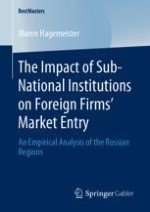2020 | Buch
Über dieses Buch
Maren Hagemeister examines how institutions influence foreign firms´ market entry decisions and subsidiary performance in Russian regions. In an empirical study the author analyses the market entries of a sample of European Union firms in the Russian federal districts between 2005 and 2013. The thesis advances prior research with its sub-national perspective on institutions and the use of the thus far underutilized Business Environment and Enterprise Performance Survey (BEEPS) to derive regional data. The findings indicate that within-country differences can significantly affect foreign companies´ entry mode and success on a local market.
Anzeige
